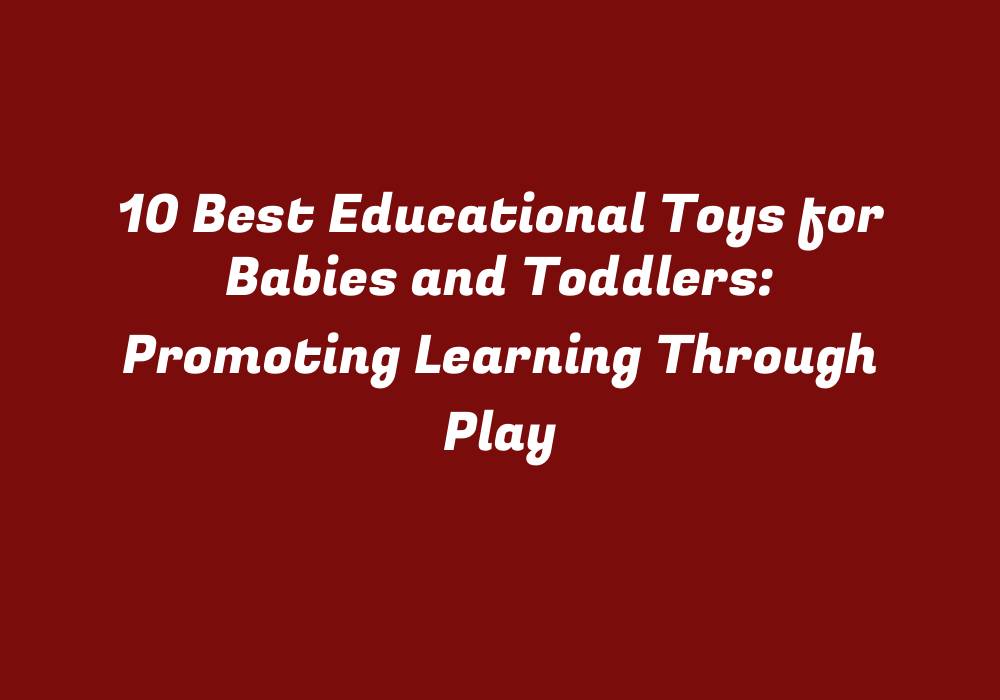10 Best Educational Toys for Babies and Toddlers: Promoting Learning Through Play
Playtime is an essential aspect of a child’s early development, as it plays a crucial role in their cognitive growth. While children learn from various sources, toys serve as excellent tools to provide educational experiences through play. Here are ten best educational toys for babies and toddlers that facilitate learning while they enjoy the fun-filled process.
1. Stacking Toys
Stacking toys, like cups or blocks, help children develop hand-eye coordination and improve fine motor skills. As babies grow into toddlers, stacking toys offer opportunities for building more complex structures and encouraging problem-solving abilities. These toys can be found in different shapes, sizes, and colors, making them interesting to engage with.
2. Puzzles
Puzzles are great educational toys that aid in developing problem-solving skills, patience, and concentration in babies and toddlers. As they attempt to fit the pieces together, their mental capacities and logical thinking abilities improve over time. Puzzle varieties include simple jigsaw puzzles, shape sorters, and interlocking blocks that can be combined into different designs.
3. Musical Toys
Musical toys not only entertain babies and toddlers but also contribute to their language development and auditory awareness. They expose young children to a wide range of sounds and instruments, which helps them develop listening skills and the ability to recognize rhythm patterns. Popular musical toys include drum sets, xylophones, and baby keyboards.
4. Sorting Toys
Sorting toys encourage color identification and shape recognition in babies and toddlers while teaching the concept of grouping objects according to similar attributes. Some examples of sorting toys include shape sorters that require the child to fit each piece into the appropriate hole, and rainbow stackers with different colored rings for sorting purposes.
5. Pretend Play Toys
Pretend play toys enable babies and toddlers to mimic adult roles and engage in imaginative play that boosts creativity. These toys include toy kitchen sets, dolls, and various types of dress-up outfits. Through roleplaying, children learn social skills such as turn-taking, sharing, and cooperating with others.
6. Push and Pull Toys
Push and pull toys help toddlers develop gross motor skills and spatial awareness by encouraging them to move around their environment. They also enhance hand-eye coordination and balance as the child tries to control these mobile objects. Popular examples include walkers, ride-on toys, and push carts with various shapes and colors for added visual stimulation.
7. Building Toys
Building toys encourage critical thinking, problem-solving skills, and spatial reasoning in babies and toddlers. Toys like Lego Duplo blocks and magnetic tiles enable children to construct various shapes and structures with an emphasis on planning, following instructions, and creating new designs. Building also promotes cooperation when working with other children or caregivers.
8. Sensory Toys
Sensory toys cater to babies’ developing senses by providing tactile experiences that encourage them to explore and learn about their surroundings. Examples include sensory bags filled with various textured materials, sensory balls containing different beads for children to roll and play with, and soft toys with unique textures.
9. Shape and Letter Toys
Shape and letter toys help build the foundation of early literacy skills in babies and toddlers by introducing them to basic concepts such as alphabet recognition and geometric shapes. Toys like magnetic letters, colorful shape puzzles, and flashcards can be used to teach children about letter formation, phonetics, and vocabulary.
10. Educational Apps
While physical toys promote hands-on learning, educational apps on mobile devices cater to a different aspect of development for babies and toddlers. These apps often incorporate elements such as games, puzzles, and interactive stories that teach letters, numbers, shapes, and more while keeping children engaged through fun animations and sound effects.
In conclusion, providing babies and toddlers with the right educational toys can significantly contribute to their growth and development in various aspects. As parents and caregivers, we should be mindful of the importance of playtime and choose toys that encourage learning through different modes such as sensory exploration, social interaction, gross motor development, and cognitive skills enhancement. By fostering a nurturing environment for early childhood education, we help shape a solid foundation upon which children can continue to grow into well-rounded individuals with diverse interests and talents.
